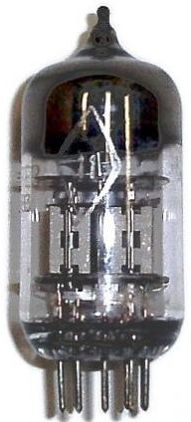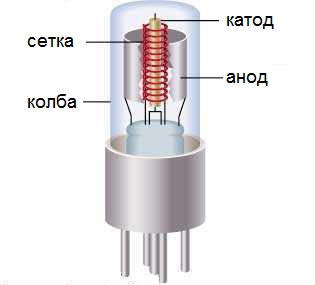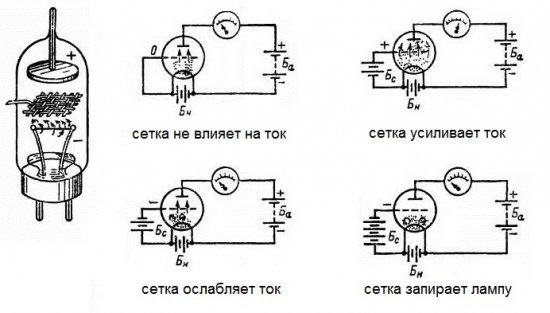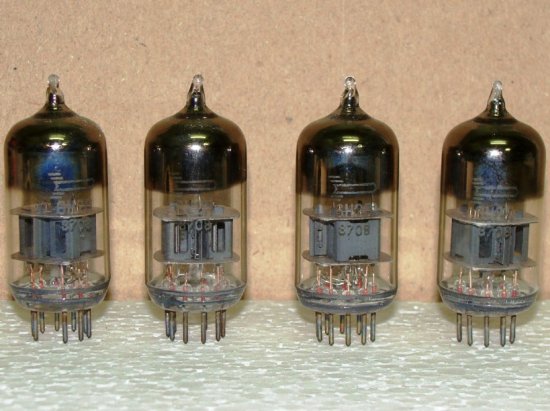Vacuum triode
There is a kettle of cold water on the kitchen table. Nothing out of the ordinary happens, the flat surface of the water only slightly trembles from someone's footsteps nearby. Now let's put the pan on the stove and not just put it on, but turn on the most intensive heating. Soon water vapor will begin to rise from the surface of the water, then boiling will begin, because even in the interior of the water column evaporation will occur, and now the water is already boiling, its intense evaporation is observed.
Here we are most interested in the phase of the experiment where only a slight heating of the water resulted in the formation of steam. But what does a pot of water have to do with it? And despite the fact that similar things happen with the cathode of an electron tube, the device of which will be discussed later.
The cathode of a vacuum tube begins to emit electrons if it is heated to 800-2000 ° C — this is a manifestation of thermionic radiation. During thermal radiation, the thermal motion of electrons in the cathode metal (usually tungsten) becomes powerful enough for some of them to overcome the energy work function and physically leave the cathode surface.
To improve electron emission, the cathodes are coated with barium, strontium or calcium oxide. And for the direct initiation of the thermionic radiation process, the cathode in the form of a hair or cylinder is heated by a built-in filament (indirect heating) or by a current directly passed through the body of the cathode (direct heating).
Indirect heating is in most cases preferable because even if the current is pulsating in the heating supply circuit, it will not be able to create significant disturbances in the anode current.

The entire described process takes place in an evacuated flask, inside which there are electrodes, of which there are at least two - the cathode and the anode. By the way, anodes are usually made of nickel or molybdenum, less often of tantalum and graphite. The shape of the anode is usually a modified parallelepiped.
Additional electrodes — grids — may be present here, depending on the number of which the lamp will be called a diode or kenotron (when there are no grids at all), a triode (if there is one grid), a tetrode (two grids) or a pentode (three grids).
Electronic lamps for different purposes have different numbers of networks, the purpose of which will be discussed further. In one way or another, the initial state of the vacuum tube is always the same: if the cathode is heated enough, an «electron cloud» is formed around it from the electrons that escaped due to thermionic radiation.

So, the cathode heats up and a "cloud" of emitted electrons already hovers near it. What are the possibilities for further development of events? If we consider that the cathode is coated with barium, strontium or calcium oxide and therefore has a good emission, then the electrons are emitted quite easily and you can do something tangible with them.
Take a battery and connect its positive terminal to the anode of the lamp and connect the negative terminal to the cathode. The electron cloud will repel from the cathode, obeying the law of electrostatics, and rush in an electric field to the anode - an anode current will arise, since electrons in a vacuum move quite easily, despite the fact that there is no conductor as such.
By the way, if in an attempt to get a more intense thermionic emission, one begins to overheat the cathode or excessively increases the anode voltage, then the cathode will soon lose emission. It is like boiling water from a pot that has been left on a very high heat.
Now let's add an additional electrode between the cathode and the anode (in the form of a wire wound in the form of a grid on the grids) - a grid. It turns out not a diode, but a triode. And here there are options for the behavior of the electrons. If the grid is directly connected to the cathode, then it will not interfere with the anode current at all.
If a certain (small compared to the anode voltage) positive voltage from another battery is applied to the network, then it will attract electrons from the cathode to itself and somewhat accelerate the electrons flying to the anode, passing them further through itself - to the anode. If a small negative voltage is applied to the grid, it will slow down the electrons.
If the negative voltage is too great, the electrons will remain floating near the cathode, failing to cross the grid at all, and the lamp will be locked out. If an excessive positive voltage is applied to the grid, it will draw most of the electrons to itself and not pass them to the cathode, until the lamp can finally deteriorate.
Thus, by properly adjusting the network voltage, it is possible to control the magnitude of the anode current of the lamp without acting directly on the source of the anode voltage. And if we compare the effect on the anode current by changing the voltage directly on the anode and changing the voltage in the network, then it is obvious that the influence through the network is less energetically expensive, and this ratio is called the gain of the lamp:

The slope of the I — V characteristic of an electron tube is the ratio of the change in anode current to the change in grid voltage at constant anode voltage:

That is why this network is called a control network. With the help of a control network, a triode works, which is used to amplify electrical oscillations in different frequency ranges.
One of the popular triodes is the dual 6N2P triode, which is still used in driver (low-current) stages of high-quality audio amplifiers (ULF).


